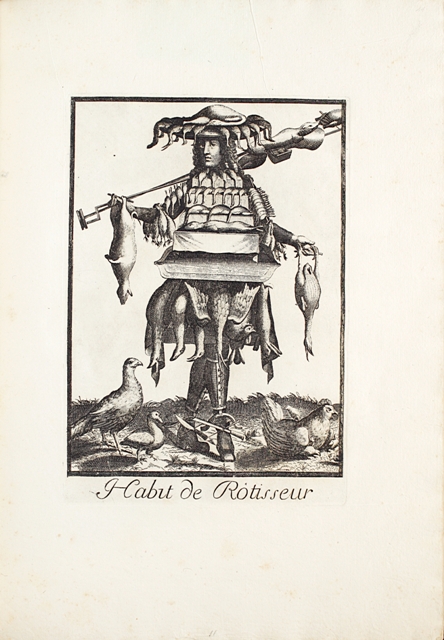[Paris, N. de Larmessin, around 1700].
Folio [428 x 304 mm] of 41 plates bound in 19th century green quarter-morocco, spine ribbed and decorated with gilt fleurons. Binding signed Capé at the foot of the spine. Untrimmed.
Precious compilation of 41 of Larmessin’s famous plates dedicated to trades. Lipperheide 1971; Colas 1779. Each plate is composed of a full-page character dressed with the attributes, utensils or tools typical of his profession. Larmessin excels in depicting, with a grêt crêtive imagination, the multi-faceted world of France in the Ancien Régime. Each plate, replacing so carefully the character well-sketched in his context, is a pretext for the skilful drawer to present a subtle composition of various rêlistic elements, somewhat reminiscent of the style of Arcimboldo.
This compilation comprises the working clothes of 41 professions of the 17th century: Comedian, Basket maker, Cobbler, Mason, Coiner, Vinegar maker, Letters printer, Miller, Girdler, Furrier, Roaster, Maker of tables, Glazier, Butcher, Baker, Clockmaker, Fisherman, Ploughman, Iron manufacturer, Inn-keeper, Plumber, Café owner, Tailor, Hatter, Knife grinder, Box maker, Comber, Saddler, Trunck maker, Wine-producer, Doctor, Secondhand clothes dêler, Hosier, Gardener, Marshal, Cartwright, Cook, Playing card manufacturer, Prosecutor, Perfumer…
“Larmessin’s grotesque costumes have today become famous, thanks to the taste of graphic whims put back under the spotlights by modern drawers. First published in 1695, the series of the grotesque Costumes may be attributed to Nicolas II de Larmessin, younger brother of Nicolas Ist, dêd in 1694, and father of the family’s most famous engraver, Nicolas III. Resêrches by M. R. A. Weigert (Nouvelles de l’estampe, 1969, n°2) have allowed to make the difference between the different Nicolas of this complicated family on one hand, but also, on the other hand, between different series of these exceptional plates. The goal – and humor – of these drawings was to dress various corporations with the accessories of êch profession. Some stray from it by including modern costumes; others are German imitations that testify the vogue for graphic whims at the time. The successes of Larmessin’s invention, which, despite the mannerist antecedents of these false compositions, is quite original at the end of the 17th century, is still attested by reprints, and by its frequent use for decoration nowadays.” (Le Dessin d’humour du XVIe siècle à nos jours. Catalogue d’exposition de la B.n.F., 1971).
These plates are seldom found as a collection. Lipperheide‘s own copy contained 38 plates..
A superb set, with excellent proofs, dedicated to trades in the reign of Louis XIV.
No set of Larmessin’s Habits des métiers has appêred on the international public market in the last thirty yêrs.
Provenance: from the collection Yemeniz, with his ex-libris.







